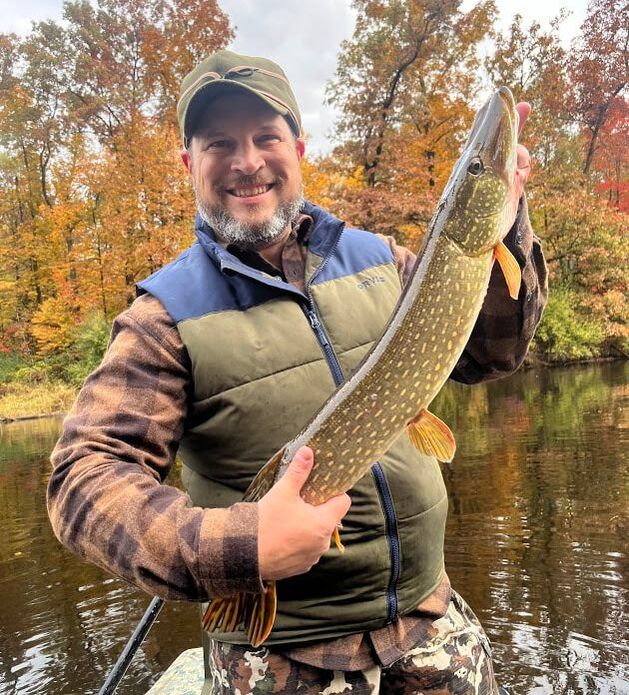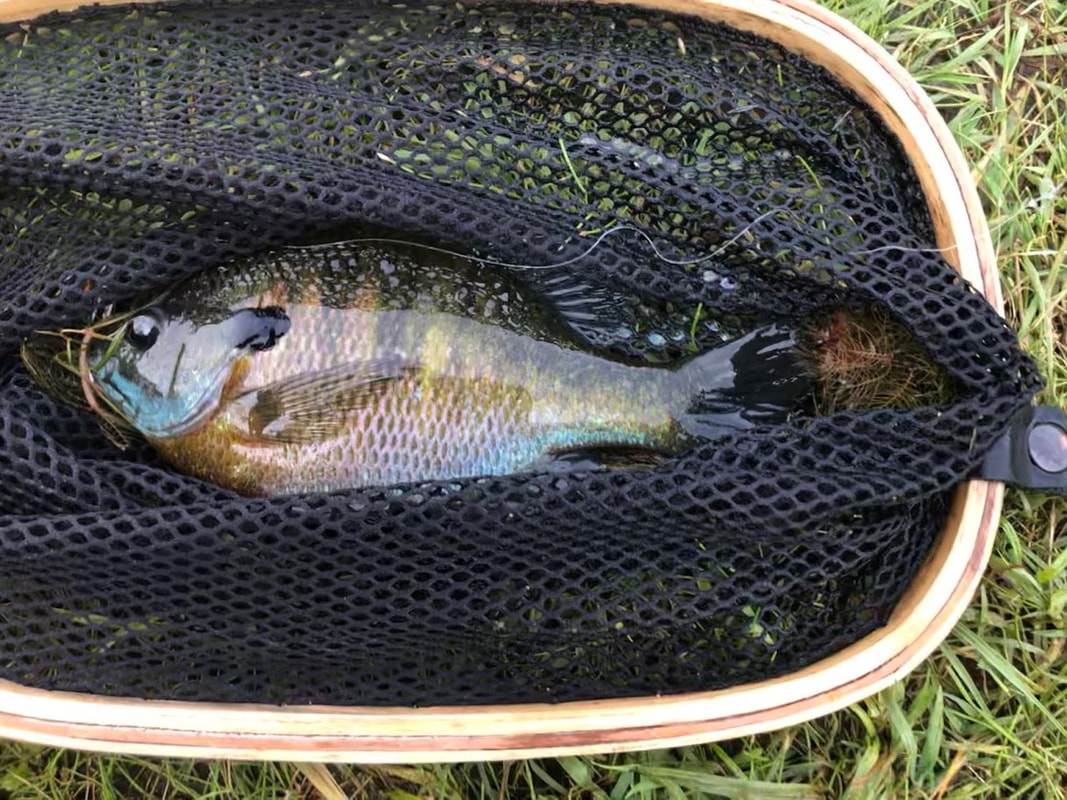|
By Drew YoungeDyke (Originally published in the August 2020 issue of Woods-n-Waters News)
It’s fortunate that some of the simplest fish to catch are also some of the most fun and accessible: panfish on public land lakes. Public land lakes are open to everyone and fish like bluegills, pumpkinseeds, and crappies are fun for everyone from the beginner to the expert to catch due to their abundance, appetite, fight, and mild flavor when kept and cooked. And as more people are venturing outdoors to paddle and fish to maintain social distance, Congress is advancing bipartisan legislation to provide greater public access to fishable waters to catch them. Earlier this summer, I packed a deflated fishing float tube in a backpack and hiked just under a mile from a parking area along a trail to a lake within the Bald Mountain Recreation Area in northern Oakland County. The trail runs along a grassy water control structure for the little warmwater lake where I’ve had success in past years fly fishing for bluegills and largemouth bass from shore. With a float tube and a couple boxes of flies I tied this year, though, I wanted to fish the whole lake and catch some largemouth bass or northern pike. While inflating my float tube and assembling my fly rod, though, I could see bluegills and pumpkinseeds on their gravel beds near shore where I planned to launch, so I tied on a little foam hopper I tied up this spring. I cast it just past the bluegills and stripped it lightly over top of them so the foam lip could pop the water like a little bass popper. Curious bluegills swam up to it and nibbled until one took a confident bite and I set the hook. Immediately the bluegill exploded, darting every which way underwater trying to free the hook. I played it lightly since I’d only brought my 9-weight rod for casting larger bass bugs and pike streamers, but it was still fun even on that heavy line. The six-inch bluegill was my first on a fly I’d tied, to which I quickly added six- and seven-inch pumpkinseeds and a crappie. Content with my shoreline panfish catch, I launched my float tube and fished the weed edges, structure, and shaded pockets along the shoreline. A green bass popper was too big for the dozens of panfish that nibbled at it, but I finally connected with a topwater largemouth bass that fought with everything it had, burying itself in weeds before I scooped it out with my net. What fun! I passed a pair of anglers in a green canoe on the way back to the launch and we chatted briefly at a distance. Mike and Megan Schumer, father and daughter, lived nearby and showed me the full catch of crappies they’d already reeled in from the lake for a panfish dinner. That’s what it’s all about, I thought. I returned for a few hours for the next three days and caught 29 total fish, mostly bluegills and pumpkinseeds, a few largemouth bass, and a pair of crappies, including one which took the 2/0 red and white Clouser Minnow I tied for northern pike! One of those days I kept five bluegills and pumpkinseeds over six inches, filleted them and pan-fried them for a fish taco lunch the next day, all courtesy of our public lands. The Bald Mountain Recreation Area is state-owned public land acquired in large part by a $197,000 grant from the Land and Water Conservation Fund (LWCF) approved in 1966 just after the fund was created by Congress in 1965. The LWCF operates on the same principle as the Michigan Natural Resources Trust Fund, created a decade later. It uses the royalties from offshore gas and oil development – not taxes - to acquire and develop outdoor recreation opportunities for everything from public land, trails, and boat launches to baseball fields and park pavilions. Last year, the LWCF was permanently authorized through the John D. Dingell Conservation, Management and Recreation Act, a welcome example of bipartisanship for our public lands. However, only twice in its 55-year history has Congress ever actually appropriated the full amount authorized to the Land and Water Conservation Fund. Which means that every dollar less than that full amount has been money intended for the LWCF but siphoned to other uses. That could finally change thanks bipartisan legislation moving through Congress as of this writing. The Great American Outdoors Act (GAOA) will permanently fund the Land and Water Conservation Fund to its full authorized amount of $900 million each year, as well as fund a backlog of maintenance projects at federal national parks and other public lands. The National Wildlife Federation and the Congressional Sportsmen’s Foundation worked to ensure that federal public lands open to hunting like Bureau of Land Management, U.S. Fish and Wildlife, and U.S. Forest Service lands were included. The GAOA recently passed the U.S. Senate, considered its biggest hurdle, and as of this writing is expected to be soon considered by the U.S. House of Representatives. In Michigan, though, one of the biggest beneficiaries of Land and Water Conservation Fund grants has been anglers, as much of it has been used to acquire and develop boat launches and the acquisition of public lands containing fishable water like Bald Mountain Recreation Area (which also received LWCF funding to develop its shooting range). The passage of the Great American Outdoors Act will ensure that even more investments in public water access and public lands can be made in more places, providing future generations with places to fish. I returned down that same trail to that same public land lake on Father’s Day. Instead of a float tube, though, I had my 16-month-old son Noah in a backpack carrier and my 5-weight fly rod in hand. Along the way, I passed or was passed by hikers, mountain bikers, and trail runners, all of us keeping a safe distance. And while I may have tried not to notice it before, they appeared to represent multiple different races and ethnicities. We smiled and greeted each other. They wished me Happy Father’s Day, and I thanked them and wished the same, and I hoped that I was as welcoming to everyone else on the trail as they were to me. Everyone belongs outdoors, and our public lands belong to all of us. With my son on my back, I tied the same foam popper to my fly line and cast it into the near shore waters, in the pockets between the lily pads and weeds where bluegills and pumpkinseeds swam. It took a few casts until I felt that tug, the furious rush, and I played the six-inch bluegill back to shore, the first that Noah and I caught together. I held it up for him to see and he looked at it curiously, not sure what to make of it. That’s alright, I thought. He’ll be more excited in a couple years when he feels that tug for himself. We caught a few more on foam hoppers, Chernobyl ants, and a foam bass popper I tried to catch a largemouth with, but which enthused a pumpkinseed more. While we fished, people passing on the trail nearby asked questions about what I was fishing for, and with what, and I answered. Maybe they were part of the new influx of people discovering or re-discovering the outdoors as a way to social distance during this COVID-19 pandemic. Maybe now they’ll try out a worm on a hook on the old spinning rod or baitcasting reel in the garage they never used or they’ll buy a new one, and now they know a spot. I’m happy to share, because these panfish and public lands are for all. This will always be the place where my son and I caught our first fish together. Maybe we’ll come back more as he grows up and we’ll fish it often like Mike and Megan Schumer do, enjoying parent-child bonding time long after he’s a child. Maybe one of those hikers will pick up a fishing rod and catch her first fish in that same spot and feel that tug that hooks her for life. After all, isn’t that what it’s all about? |
AUTHOR
Drew YoungeDyke is an award-winning freelance outdoor writer and a Director of Conservation Partnerships for the National Wildlife Federation, a board member of the Outdoor Writers Association of America, and a member of the Association of Great Lakes Outdoor Writers and the Michigan Outdoor Writers Association.
All posts at Michigan Outside are independent and do not necessarily reflect the views of NWF, Surfrider, OWAA, AGLOW, MOWA, the or any other entity. ARCHIVES
June 2022
SUBJECTS
All
|



 RSS Feed
RSS Feed